2024届高三英语二轮复习:非谓语动词作定语课件(共14张PPT)
文档属性
| 名称 | 2024届高三英语二轮复习:非谓语动词作定语课件(共14张PPT) |  | |
| 格式 | pptx | ||
| 文件大小 | 1.8MB | ||
| 资源类型 | 教案 | ||
| 版本资源 | 通用版 | ||
| 科目 | 英语 | ||
| 更新时间 | 2023-10-22 20:06:50 | ||
图片预览


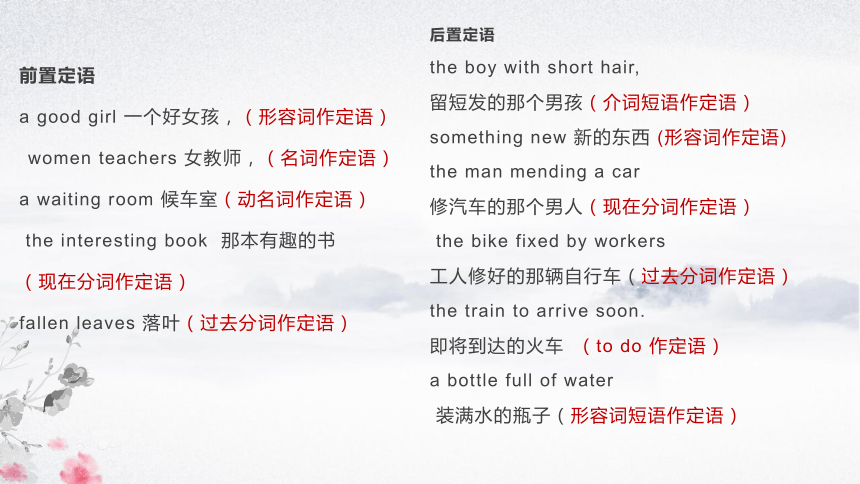
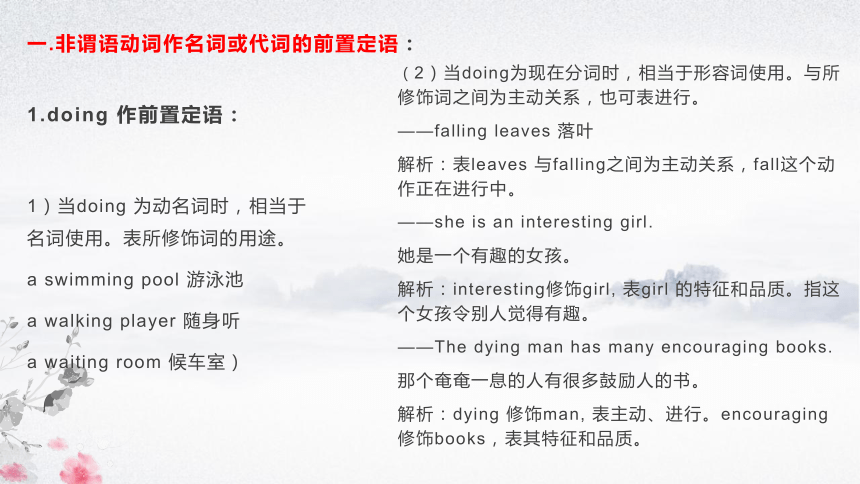
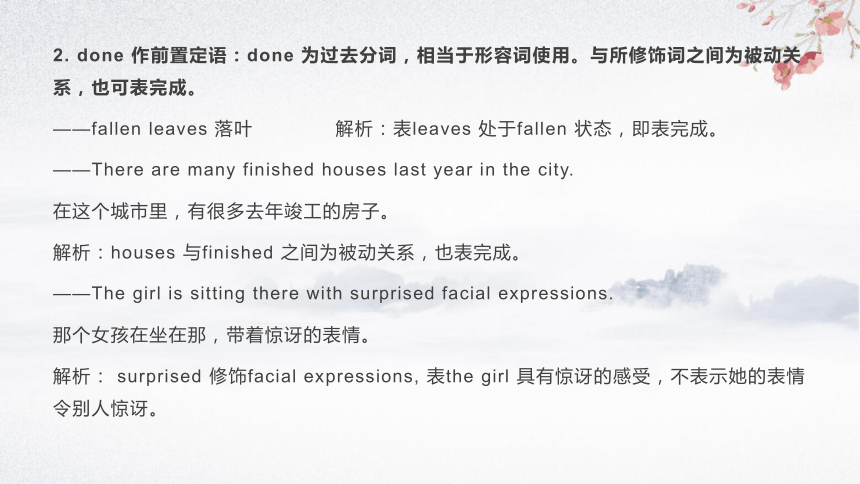
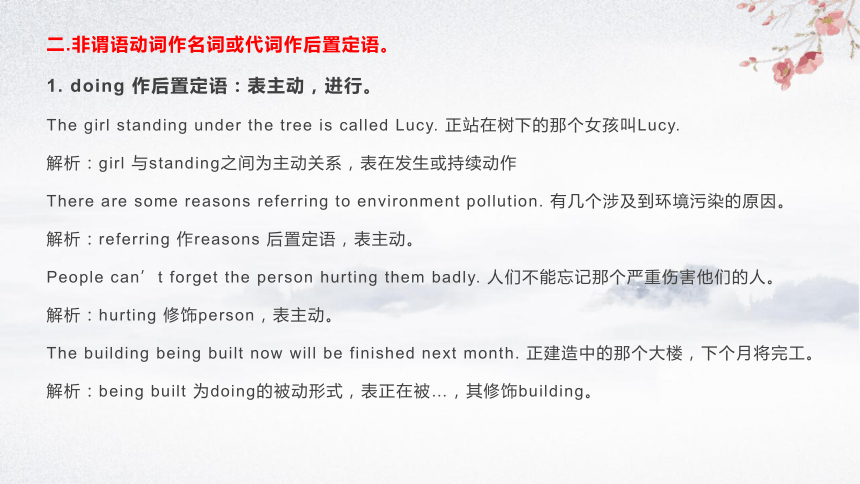
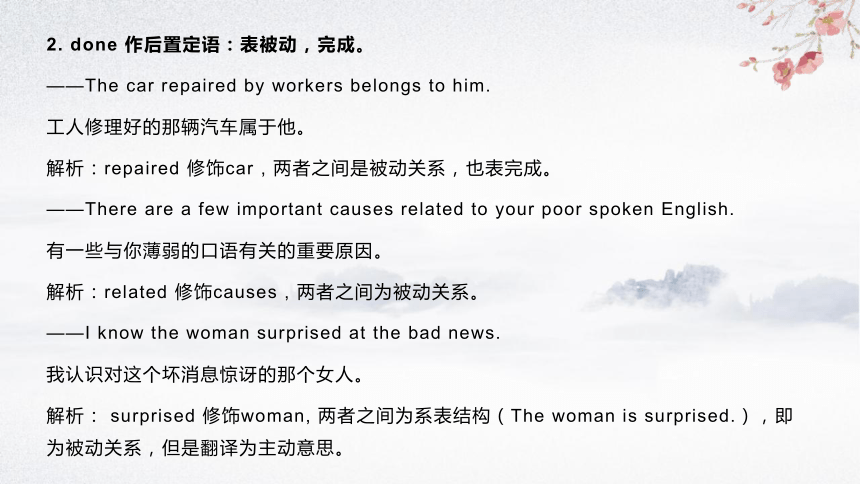
文档简介
(共14张PPT)
非谓语动词作定语
定语
修饰、限定名词或代词特征和品质的词,词组和句子
分为前置定语和后置定语
单个的分词作定语放在所修饰的词之前,分词短语作定语,放在所修饰的词之后。动词不定式只能做后置定语。
前置定语
a good girl 一个好女孩,(形容词作定语)
women teachers 女教师,(名词作定语)
a waiting room 候车室(动名词作定语)
the interesting book 那本有趣的书
(现在分词作定语)
fallen leaves 落叶(过去分词作定语)
后置定语
the boy with short hair,
留短发的那个男孩(介词短语作定语)
something new 新的东西 (形容词作定语)
the man mending a car
修汽车的那个男人(现在分词作定语)
the bike fixed by workers
工人修好的那辆自行车(过去分词作定语)
the train to arrive soon.
即将到达的火车 (to do 作定语)
a bottle full of water
装满水的瓶子(形容词短语作定语)
一.非谓语动词作名词或代词的前置定语:
1.doing 作前置定语:
1)当doing 为动名词时,相当于名词使用。表所修饰词的用途。
a swimming pool 游泳池
a walking player 随身听
a waiting room 候车室)
(2)当doing为现在分词时,相当于形容词使用。与所修饰词之间为主动关系,也可表进行。
——falling leaves 落叶
解析:表leaves 与falling之间为主动关系,fall这个动作正在进行中。
——she is an interesting girl.
她是一个有趣的女孩。
解析:interesting修饰girl, 表girl 的特征和品质。指这个女孩令别人觉得有趣。
——The dying man has many encouraging books.
那个奄奄一息的人有很多鼓励人的书。
解析:dying 修饰man, 表主动、进行。encouraging 修饰books,表其特征和品质。
2. done 作前置定语:done 为过去分词,相当于形容词使用。与所修饰词之间为被动关系,也可表完成。
——fallen leaves 落叶 解析:表leaves 处于fallen 状态,即表完成。
——There are many finished houses last year in the city.
在这个城市里,有很多去年竣工的房子。
解析:houses 与finished 之间为被动关系,也表完成。
——The girl is sitting there with surprised facial expressions.
那个女孩在坐在那,带着惊讶的表情。
解析: surprised 修饰facial expressions, 表the girl 具有惊讶的感受,不表示她的表情令别人惊讶。
二.非谓语动词作名词或代词作后置定语。
1. doing 作后置定语:表主动,进行。
The girl standing under the tree is called Lucy. 正站在树下的那个女孩叫Lucy.
解析:girl 与standing之间为主动关系,表在发生或持续动作
There are some reasons referring to environment pollution. 有几个涉及到环境污染的原因。
解析:referring 作reasons 后置定语,表主动。
People can’t forget the person hurting them badly. 人们不能忘记那个严重伤害他们的人。
解析:hurting 修饰person,表主动。
The building being built now will be finished next month. 正建造中的那个大楼,下个月将完工。
解析:being built 为doing的被动形式,表正在被…,其修饰building。
2. done 作后置定语:表被动,完成。
——The car repaired by workers belongs to him.
工人修理好的那辆汽车属于他。
解析:repaired 修饰car , 两者之间是被动关系,也表完成。
——There are a few important causes related to your poor spoken English.
有一些与你薄弱的口语有关的重要原因。
解析:related 修饰causes , 两者之间为被动关系。
——I know the woman surprised at the bad news.
我认识对这个坏消息惊讶的那个女人。
解析: surprised 修饰woman, 两者之间为系表结构(The woman is surprised.),即为被动关系,但是翻译为主动意思。
3. to do 作后置定语:表将要,修饰。
(1)动宾关系:to do作后置定语。与所修饰词之间为动宾关系,句中常有to do的逻辑主语。
——I have much work to do. 我有很多工作要做。
解析:to do 与work 为动宾关系,即to do+ work. I 为to do 的逻辑主语。表将要。
——He said he had an important meeting to attend. 他说他有一个重要会议要参加。
解析: to attend 修饰meeting , 两者之间为动宾关系,其逻辑主语为he.表将要。
—— Many people in China have no house to live in. 中国许多人没居住的房子。
解析:live 为不及物动词,且live in 与house 为动宾关系,people 为其逻辑主语。
介词in 可省略。当表时间(例如time),地点(例如place),方式(例如way),原因(例如reason)时,介词可省略。
——You have many books to choose from.
你有很多书可以选择。
解析: to choose from 修饰books, 两者之间为动宾关系。You 为逻辑主语,介词from 不可省略。
(2)主谓关系:与所修饰词之间为主动或被动关系。
The train to arrive soon comes from Shanghai. 很快要到达的火车,来自上海。(表将要)
解析: to arrive 修饰train, 表主动,将要。
There are many activities to be held/to hold next week. 有许多下周即将举办的活动。(表将要)
解析:to be held 修饰activities , 表将要,且之间为被动关系。There be 句型中,to do 或to be done 作后置定语均可。
(3)状语关系:to do 修饰名词(多为抽象名词)或代词,相当于方式,时间等状语。
——That’s the way to do this job. 这才是做这份工作的方式。
解析:to do 相当于作the way的方式状语。
——I have no time to finish all the work. 我没有时间完成所有工作。
解析:to finish 相当于作time 的时间状语。
4) 当名词或代词由the only/last/next/very, 形容词最高级(the best)或序数词修饰时,并且两者存在逻辑上的主谓关系时,用to do,to be done, done作后置定语。
He is the only person to know the truth.. 他是唯一知道真相的人。
解析:the only 修饰person,to know 修饰person , 且之间为主动关系。
The first school to be built next year is intended for children without parents.
明年即将建造的第一所学校是给没有父母的孩子们的。
解析:to be built 修饰school, 之间为被动关系,且表将要。
The first text books written by Bill for English teaching was published in the 16th century.
解析:written修饰books, 表被动,完成。
(5)to do 还可以变形为to have done, to have been done, to have been doing.
The couple to have been married for 20 years by next month are my parents.
下个月结婚20年的夫妻是我父母。
动词不定式
常用形式:
一般主动式to do 一般被动式to be done
完成主动式to have done 完成被动式to have been done
进行式to be doing
分词
分词形式:有现在分词和过去分词两种。
过去分词只有一种形式
现在分词则有:
一般主动式doing 一般被动式being done,
完成主动式having done 完成被动式having been done
三.现在分词和过去分词的区别:
1)语态不同:现在分词表示主动意义,及物动词的过去分词表示被动意义。
the moving film 动人的电影 the moved girl 受感动的姑娘,
a running machine 一台转动的机器 a stolen car 一辆被盗的汽车
2)时间关系上不同:现在分词表正在进行的动作,过去分词往往表已经完成的动作。
a developing country 发展中的国家
a developed country发达的国家
注:关于心理状态动词的-ing形式表主动意,-ed形式表被动意。
所谓心理状态动词是指含有使动意,使人产生某种情感、心理变化的动词。
surprise使惊讶;interest使感兴趣。它们的-ing形式含主动意义,-ed形式含被动意义。皆可视为形容词。
例如:surprising令人惊讶的,interesting令人感兴趣的;surprised(因…)感到惊讶的,interested(因…)感到兴趣的。
The film is so interesting that they are all interested in it.
She was much surprised at the surprising news.
已学的心理状态动词有:astonish, bore,delight, disappoint, discourage, encourage, excite, frighten, interest, move(使感动),please(使高兴),puzzle(使迷惑),satisfy(使满意),surprise, shock, tire(使疲劳)。
谢谢观看
非谓语动词作定语
定语
修饰、限定名词或代词特征和品质的词,词组和句子
分为前置定语和后置定语
单个的分词作定语放在所修饰的词之前,分词短语作定语,放在所修饰的词之后。动词不定式只能做后置定语。
前置定语
a good girl 一个好女孩,(形容词作定语)
women teachers 女教师,(名词作定语)
a waiting room 候车室(动名词作定语)
the interesting book 那本有趣的书
(现在分词作定语)
fallen leaves 落叶(过去分词作定语)
后置定语
the boy with short hair,
留短发的那个男孩(介词短语作定语)
something new 新的东西 (形容词作定语)
the man mending a car
修汽车的那个男人(现在分词作定语)
the bike fixed by workers
工人修好的那辆自行车(过去分词作定语)
the train to arrive soon.
即将到达的火车 (to do 作定语)
a bottle full of water
装满水的瓶子(形容词短语作定语)
一.非谓语动词作名词或代词的前置定语:
1.doing 作前置定语:
1)当doing 为动名词时,相当于名词使用。表所修饰词的用途。
a swimming pool 游泳池
a walking player 随身听
a waiting room 候车室)
(2)当doing为现在分词时,相当于形容词使用。与所修饰词之间为主动关系,也可表进行。
——falling leaves 落叶
解析:表leaves 与falling之间为主动关系,fall这个动作正在进行中。
——she is an interesting girl.
她是一个有趣的女孩。
解析:interesting修饰girl, 表girl 的特征和品质。指这个女孩令别人觉得有趣。
——The dying man has many encouraging books.
那个奄奄一息的人有很多鼓励人的书。
解析:dying 修饰man, 表主动、进行。encouraging 修饰books,表其特征和品质。
2. done 作前置定语:done 为过去分词,相当于形容词使用。与所修饰词之间为被动关系,也可表完成。
——fallen leaves 落叶 解析:表leaves 处于fallen 状态,即表完成。
——There are many finished houses last year in the city.
在这个城市里,有很多去年竣工的房子。
解析:houses 与finished 之间为被动关系,也表完成。
——The girl is sitting there with surprised facial expressions.
那个女孩在坐在那,带着惊讶的表情。
解析: surprised 修饰facial expressions, 表the girl 具有惊讶的感受,不表示她的表情令别人惊讶。
二.非谓语动词作名词或代词作后置定语。
1. doing 作后置定语:表主动,进行。
The girl standing under the tree is called Lucy. 正站在树下的那个女孩叫Lucy.
解析:girl 与standing之间为主动关系,表在发生或持续动作
There are some reasons referring to environment pollution. 有几个涉及到环境污染的原因。
解析:referring 作reasons 后置定语,表主动。
People can’t forget the person hurting them badly. 人们不能忘记那个严重伤害他们的人。
解析:hurting 修饰person,表主动。
The building being built now will be finished next month. 正建造中的那个大楼,下个月将完工。
解析:being built 为doing的被动形式,表正在被…,其修饰building。
2. done 作后置定语:表被动,完成。
——The car repaired by workers belongs to him.
工人修理好的那辆汽车属于他。
解析:repaired 修饰car , 两者之间是被动关系,也表完成。
——There are a few important causes related to your poor spoken English.
有一些与你薄弱的口语有关的重要原因。
解析:related 修饰causes , 两者之间为被动关系。
——I know the woman surprised at the bad news.
我认识对这个坏消息惊讶的那个女人。
解析: surprised 修饰woman, 两者之间为系表结构(The woman is surprised.),即为被动关系,但是翻译为主动意思。
3. to do 作后置定语:表将要,修饰。
(1)动宾关系:to do作后置定语。与所修饰词之间为动宾关系,句中常有to do的逻辑主语。
——I have much work to do. 我有很多工作要做。
解析:to do 与work 为动宾关系,即to do+ work. I 为to do 的逻辑主语。表将要。
——He said he had an important meeting to attend. 他说他有一个重要会议要参加。
解析: to attend 修饰meeting , 两者之间为动宾关系,其逻辑主语为he.表将要。
—— Many people in China have no house to live in. 中国许多人没居住的房子。
解析:live 为不及物动词,且live in 与house 为动宾关系,people 为其逻辑主语。
介词in 可省略。当表时间(例如time),地点(例如place),方式(例如way),原因(例如reason)时,介词可省略。
——You have many books to choose from.
你有很多书可以选择。
解析: to choose from 修饰books, 两者之间为动宾关系。You 为逻辑主语,介词from 不可省略。
(2)主谓关系:与所修饰词之间为主动或被动关系。
The train to arrive soon comes from Shanghai. 很快要到达的火车,来自上海。(表将要)
解析: to arrive 修饰train, 表主动,将要。
There are many activities to be held/to hold next week. 有许多下周即将举办的活动。(表将要)
解析:to be held 修饰activities , 表将要,且之间为被动关系。There be 句型中,to do 或to be done 作后置定语均可。
(3)状语关系:to do 修饰名词(多为抽象名词)或代词,相当于方式,时间等状语。
——That’s the way to do this job. 这才是做这份工作的方式。
解析:to do 相当于作the way的方式状语。
——I have no time to finish all the work. 我没有时间完成所有工作。
解析:to finish 相当于作time 的时间状语。
4) 当名词或代词由the only/last/next/very, 形容词最高级(the best)或序数词修饰时,并且两者存在逻辑上的主谓关系时,用to do,to be done, done作后置定语。
He is the only person to know the truth.. 他是唯一知道真相的人。
解析:the only 修饰person,to know 修饰person , 且之间为主动关系。
The first school to be built next year is intended for children without parents.
明年即将建造的第一所学校是给没有父母的孩子们的。
解析:to be built 修饰school, 之间为被动关系,且表将要。
The first text books written by Bill for English teaching was published in the 16th century.
解析:written修饰books, 表被动,完成。
(5)to do 还可以变形为to have done, to have been done, to have been doing.
The couple to have been married for 20 years by next month are my parents.
下个月结婚20年的夫妻是我父母。
动词不定式
常用形式:
一般主动式to do 一般被动式to be done
完成主动式to have done 完成被动式to have been done
进行式to be doing
分词
分词形式:有现在分词和过去分词两种。
过去分词只有一种形式
现在分词则有:
一般主动式doing 一般被动式being done,
完成主动式having done 完成被动式having been done
三.现在分词和过去分词的区别:
1)语态不同:现在分词表示主动意义,及物动词的过去分词表示被动意义。
the moving film 动人的电影 the moved girl 受感动的姑娘,
a running machine 一台转动的机器 a stolen car 一辆被盗的汽车
2)时间关系上不同:现在分词表正在进行的动作,过去分词往往表已经完成的动作。
a developing country 发展中的国家
a developed country发达的国家
注:关于心理状态动词的-ing形式表主动意,-ed形式表被动意。
所谓心理状态动词是指含有使动意,使人产生某种情感、心理变化的动词。
surprise使惊讶;interest使感兴趣。它们的-ing形式含主动意义,-ed形式含被动意义。皆可视为形容词。
例如:surprising令人惊讶的,interesting令人感兴趣的;surprised(因…)感到惊讶的,interested(因…)感到兴趣的。
The film is so interesting that they are all interested in it.
She was much surprised at the surprising news.
已学的心理状态动词有:astonish, bore,delight, disappoint, discourage, encourage, excite, frighten, interest, move(使感动),please(使高兴),puzzle(使迷惑),satisfy(使满意),surprise, shock, tire(使疲劳)。
谢谢观看
